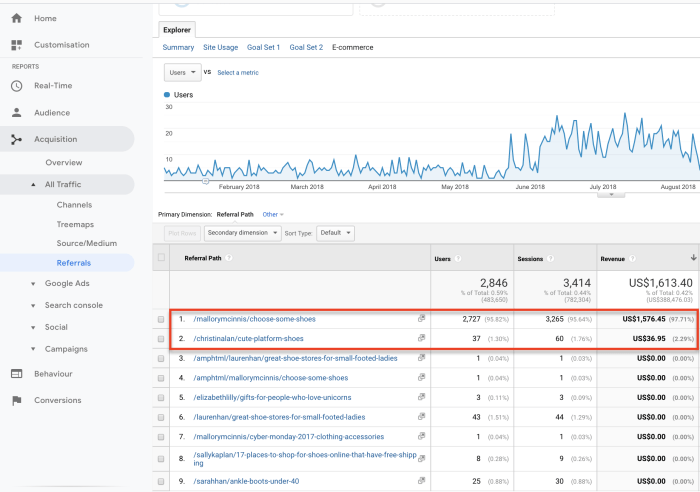Referral paths in Google Analytics provide a crucial lens into where your website traffic originates. Understanding these paths—from direct visits to social media referrals—uncovers valuable insights into how users discover and interact with your site. This exploration delves into defining referral paths, identifying key metrics, analyzing performance, optimizing results, and using data for informed decisions. We’ll dissect different types of referrals, the metrics to track, and ultimately, how to leverage this data for a more effective online strategy.
By understanding the various channels driving traffic to your website, you can gain a deeper comprehension of user behavior and effectively tailor your online presence to maximize engagement and conversions. This analysis goes beyond simply counting visitors; it helps you understand
-why* they’re coming to your site and what actions they’re taking once there.
Defining Referral Paths in Google Analytics

Referral paths in Google Analytics reveal how users arrive at your website from other sources. Understanding these paths is crucial for optimizing your marketing strategies and improving website traffic. They provide insights into user behavior, highlighting effective marketing channels and areas for improvement. This data helps you to better target your audience and allocate resources effectively.Knowing where your visitors come from gives you valuable context about their journey and how they interact with your site.
For example, if a significant portion of your traffic originates from a particular social media platform, you might want to explore ways to further leverage that platform.
Referral Path Types
Referral paths represent the journey users take to reach your website from external sources. This section details the various categories of referral paths, helping to identify their origins and importance. Categorizing traffic sources enables you to tailor your marketing strategies and improve user engagement.
- Direct Traffic: Users directly type in your website’s URL or bookmark it. This indicates strong brand recognition or repeat visits.
- Search Engine Traffic: Users find your site through search engines like Google, Bing, or DuckDuckGo. This suggests the importance of your website’s visibility in search results.
- Social Media Traffic: Users arrive from social media platforms such as Facebook, Twitter, Instagram, or Pinterest. This emphasizes the potential of social media as a marketing channel.
- Email Traffic: Users click on links within email newsletters or promotional campaigns. This indicates the effectiveness of email marketing strategies.
- Referral Traffic from Other Websites: Users arrive from other websites, including partner sites, blogs, or industry publications. This highlights the value of collaborations and external links.
Differences from Other Traffic Sources
Referral paths differ from other traffic sources like organic or paid search. While all these sources contribute to overall website traffic, referral paths specifically pinpoint the source website or platform driving traffic to your site. Understanding the distinction is key to assessing the effectiveness of external partnerships or marketing campaigns.
- Organic Traffic: Users reach your site through search engine results pages (SERPs) without paying for ads. This is a natural way to drive traffic, emphasizing the quality of your website’s content.
- Paid Traffic: Users reach your site through paid advertisements on search engines or other platforms. This focuses on targeted advertising and direct traffic generation.
Examples of Referral Paths
Different scenarios demonstrate how referral paths work in practice. These examples illustrate how analyzing referral paths helps understand user behavior and improve marketing efforts.
Understanding referral paths in Google Analytics is crucial for website optimization. Knowing where your traffic is coming from helps you identify high-value sources and improve your marketing strategies. Sometimes, you might discover that your content has been copied, and you need to find and remove stolen content, which can significantly impact your referral traffic. Tools like find remove stolen content can help in this process.
Once you’ve addressed any copied content, you can get a clearer picture of your referral paths and how to drive more authentic traffic to your site.
- A user bookmarks your website and returns directly to it. This falls under direct traffic, suggesting strong brand loyalty and user engagement.
- A user searches for “best running shoes” on Google and clicks a link to your website’s product page. This is search engine traffic, highlighting the importance of search engine optimization ().
- A user clicks a link to your website from a partner website’s blog post. This is referral traffic from other websites, demonstrating the effectiveness of collaborations.
Referral Path Source Table
This table summarizes different referral path types and potential sources. This structured view helps quickly identify the origin of website traffic.
| Path Type | Potential Source |
|---|---|
| Direct | Bookmark, typed URL |
| Search Engine | Google, Bing, DuckDuckGo |
| Social Media | Facebook, Twitter, Instagram |
| Newsletter sign-ups | |
| Other Websites | Partner sites, blogs |
Analyzing Referral Path Performance: Referral Paths In Google Analytics

Understanding how different referral sources contribute to your website traffic is crucial for optimizing your marketing efforts. Analyzing referral paths in Google Analytics goes beyond simply identifying where visitors come from; it delves into the effectiveness of those paths in driving desired actions like conversions. This deeper understanding allows you to fine-tune your strategies and allocate resources more efficiently.Interpreting the data from referral paths allows you to identify strengths and weaknesses in your marketing channels.
For instance, a high bounce rate from a specific referral source might indicate a problem with the landing page or the relevance of the content. Conversely, a high conversion rate from a particular referral source suggests that channel is highly effective and worth investing in.
Interpreting Referral Path Data
Different referral sources contribute to website traffic in unique ways. Understanding the traffic source’s characteristics, like its typical visitor demographics or interests, is vital for effective analysis. For example, a referral source focused on a younger audience might have a higher bounce rate, while a source targeting professionals might have a higher conversion rate. This contextual understanding helps you interpret the data accurately.
Evaluating Referral Source Effectiveness
Evaluating the effectiveness of different referral sources involves a multi-faceted approach. Metrics like session duration, bounce rate, and conversion rate are crucial. A high bounce rate from a particular source, coupled with a low conversion rate, might indicate a mismatch between the source’s audience and your site’s offerings. Conversely, a high conversion rate suggests a successful marketing campaign that effectively targets the desired audience.
Understanding referral paths in Google Analytics is key to optimizing your website’s performance. Knowing where your traffic is coming from is crucial, and a great way to improve this is by using live customer chat, which can help you identify key pain points and areas for improvement. Check out these 25 live customer chat tips 25 live customer chat tips to learn how to use it effectively.
This in turn helps you understand the journeys your visitors take and ultimately, improve the quality of your referral paths in Google Analytics.
Comparing Referral Path Performance, Referral paths in google analytics
Comparing the performance of various referral paths is essential for identifying the most valuable channels. This comparison helps in resource allocation and strategic adjustments. For example, if a search engine referral source consistently outperforms social media, it indicates a stronger need for optimizing search engine marketing strategies.
Referral Path Performance Comparison
| Referral Source | Sessions | Bounce Rate | Conversion Rate |
|---|---|---|---|
| Social Media | 1000 | 40% | 2% |
| Search Engine | 1500 | 30% | 5% |
The table above presents a simplified example of referral path performance. The search engine referral source, despite having more sessions, demonstrates a better conversion rate compared to social media. This indicates that search engine traffic is more valuable in terms of driving conversions. Further investigation is needed to understand the specific s driving the search engine traffic and to optimize the content to better match the search intent.
Also, understanding the specific landing pages for each referral source is crucial. If the social media traffic is landing on a page less relevant to the audience, the bounce rate would be high.
Optimizing Referral Path Performance
Referral paths are crucial for understanding how users arrive at your website. Identifying high-performing and underperforming referral sources allows you to focus resources on strategies that yield the best results. Optimizing these paths is about enhancing the user journey, maximizing engagement, and ultimately, boosting conversions.Understanding your referral paths isn’t just about knowing
- where* people come from; it’s about understanding
- why* they’re coming and what motivates them to engage with your content. By tailoring your strategies to the unique characteristics of each referral source, you can significantly improve your website’s overall performance.
Strategies for Improving High-Value Referral Paths
High-value referral paths are those that consistently drive valuable traffic and conversions. To maximize their impact, consider these strategies:
- Improve Content Relevance: Tailor the content on your website to match the interests and needs of users coming from high-performing referral sources. For example, if a significant portion of your traffic comes from a specific blog, ensure your landing pages align with the blog’s theme and provide relevant information. This alignment builds trust and encourages engagement.
- Optimize Landing Pages: Design landing pages specifically for users coming from different referral sources. Consider the context of the referral and create landing pages that resonate with that context. For instance, a landing page for users coming from a social media campaign should be tailored to the specific campaign’s message and offer.
- Enhance User Experience: A seamless user experience is crucial for converting visitors into customers. Ensure your website’s navigation is intuitive and your interface is user-friendly, regardless of the referral source. A well-designed website enhances user satisfaction and encourages repeat visits.
Strategies for Enhancing Engagement with Different Sources
Different referral sources often require tailored engagement strategies.
- Content Marketing Referral Sources: If a large portion of your traffic comes from your own blog or articles, focus on creating high-quality, engaging content that resonates with your target audience. Promote related content through internal links to encourage further exploration.
- Social Media Referral Sources: For social media referrals, use compelling visuals and engaging copy to keep users on your site. Offer interactive elements, such as quizzes or polls, to boost engagement.
- Paid Advertising Referral Sources: For paid advertising, ensure your ads clearly communicate the value proposition of your product or service. Optimize your landing pages to align with the specific ad copy and offer a seamless user experience.
Steps Involved in Optimizing Referral Paths
Optimizing referral paths is a multi-step process.
- Identify High-Performing and Underperforming Sources: Analyze your Google Analytics data to pinpoint which referral sources are driving the most valuable traffic and which are underperforming. Track key metrics like conversion rates and bounce rates for each source.
- Analyze User Behavior: Dive deeper into the behavior of users from each source. Understand which pages they visit, how long they stay, and what actions they take. This detailed analysis will help you understand the user journey and identify areas for improvement.
- Implement Changes: Based on your analysis, implement changes to your website, content, or campaigns. Track the impact of these changes on key metrics.
- Iterate and Refine: Continuously monitor the performance of your referral paths and make adjustments as needed. This iterative approach ensures your strategies are always aligned with your goals.
Identifying and Addressing Underperforming Referral Sources
Underperforming referral sources may be due to several factors, including irrelevant content, poor landing pages, or an unsatisfactory user experience.
Understanding referral paths in Google Analytics is crucial. It helps pinpoint where your traffic is coming from, but often, those valuable visitors end up in a “customer who doesn’t convert” category. This group can offer valuable insights into what’s missing in your website’s journey to a sale. Analyzing these referral paths alongside this “customer who doesn’t convert” data can reveal bottlenecks in your sales funnel and improve your conversion rates.
- Identify the Root Cause: Examine the reasons behind the underperformance. Is the content irrelevant to the source’s audience? Are landing pages poorly designed? Is the site navigation confusing?
- Implement Solutions: Develop solutions to address the identified issues. Tailor the content to match the source’s audience, redesign landing pages, and improve site navigation.
- Test and Evaluate: Track the impact of implemented changes on key metrics. Evaluate whether the improvements have positively affected user behavior and conversions.
Strategies to Improve Underperforming Sources
Strategies to improve underperforming referral sources are often similar to strategies for high-performing sources, but with a greater emphasis on addressing specific issues.
| Strategy | Description |
|---|---|
| Improve Content Relevance | Tailor content to match user interests. |
| Optimize Landing Pages | Design landing pages that are relevant to referral sources. |
| Enhance User Experience | Improve site navigation and user interface. |
Using Referral Paths for Data-Driven Decisions
Referral paths in Google Analytics offer a wealth of information about how users arrive at your website. This data isn’t just a curiosity; it’s a powerful tool for understanding user behavior, optimizing marketing efforts, and ultimately, boosting your bottom line. By carefully analyzing referral paths, you can identify successful strategies, pinpoint areas for improvement, and make data-driven decisions that yield tangible results.Understanding user journeys is crucial for any successful online business.
Referral paths provide a clear picture of these journeys, revealing which sources are most effective in driving traffic and conversions. This insight allows you to strategically allocate resources and optimize your marketing campaigns for maximum impact.
Strategic Decision-Making with Referral Path Data
Analyzing referral path data empowers you to make informed choices about your marketing strategy. By identifying high-performing referral sources, you can allocate more resources to those channels. Conversely, understanding underperforming sources helps you identify areas where adjustments or complete shifts in strategy might be necessary. This is a crucial step in maximizing ROI and efficiency.
Implementing Data-Driven Decisions Based on Referral Path Analysis
Implementing data-driven decisions based on referral path analysis involves a systematic process.
- Data Collection and Analysis: First, collect comprehensive referral path data using Google Analytics. Thoroughly analyze the data, paying attention to the volume of traffic from different sources, conversion rates, and the overall user journey.
- Identifying High-Performing Channels: Pinpoint the referral sources that consistently drive high-quality traffic and conversions. Examine the metrics to determine the most effective sources in terms of engagement and revenue generation. This might involve specific marketing campaigns, social media platforms, or partner websites.
- Identifying Underperforming Channels: Scrutinize referral sources that are not performing as expected. Determine if the traffic quality is low or if conversion rates are significantly lower than other channels. This can help in identifying issues with the campaigns or the content that the source is directing traffic to.
- Adjusting Marketing Strategies: Use the insights to refine your marketing strategy. Increase investment in high-performing channels to amplify their impact. Alternatively, adjust or eliminate campaigns or content from underperforming sources. For example, if a specific social media platform is not generating conversions, consider shifting budget towards a more successful channel.
- Monitoring and Iteration: Continuously monitor the performance of your adjusted strategies. Track key metrics like traffic volume, conversion rates, and customer acquisition cost (CAC). Be prepared to adapt your approach based on the ongoing performance data. This iterative process allows for a dynamic and responsive marketing strategy that aligns with evolving trends and customer behavior.
Importance of Incorporating Referral Path Insights into Marketing Strategies
Integrating referral path insights into your marketing strategy allows you to tailor your efforts to resonate with your target audience more effectively. Understanding where your customers are coming from and how they’re interacting with your website provides valuable information about their needs and preferences. This allows you to personalize your content and messaging to improve engagement and conversions.
Long-Term Benefits of Leveraging Referral Path Data
Leveraging referral path data provides several long-term benefits. By understanding where your traffic originates, you can optimize your website and marketing campaigns for better performance over time. This leads to increased efficiency, improved ROI, and a more robust online presence. This translates into a sustainable growth strategy.
Example: Adjusting Marketing Budget Allocations
Imagine your website receives significant traffic from social media platform A and blog B. Social media referrals consistently convert at a higher rate than those from blog B. Google Analytics data reveals that users from social media platform A spend more time on your website and are more likely to make purchases.
Based on this data, you should increase the budget allocated to social media platform A. This reallocation allows you to maximize the return on investment from the more effective channel. Conversely, consider decreasing or adjusting the budget allocated to blog B to evaluate other potential sources or optimize the content to increase conversion rates.
By understanding these insights, you can allocate resources effectively, leading to a more efficient and successful online marketing campaign.
Conclusion
In conclusion, analyzing referral paths in Google Analytics is a powerful way to optimize your website’s performance and drive better results. By understanding where your traffic is coming from, you can fine-tune your marketing strategies, improve user experience, and ultimately, boost your bottom line. This comprehensive guide has equipped you with the tools and knowledge to unlock the full potential of your referral data and make informed decisions about your online presence.






